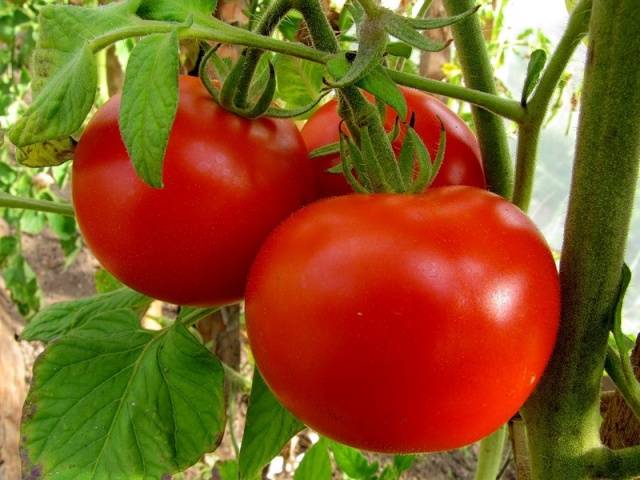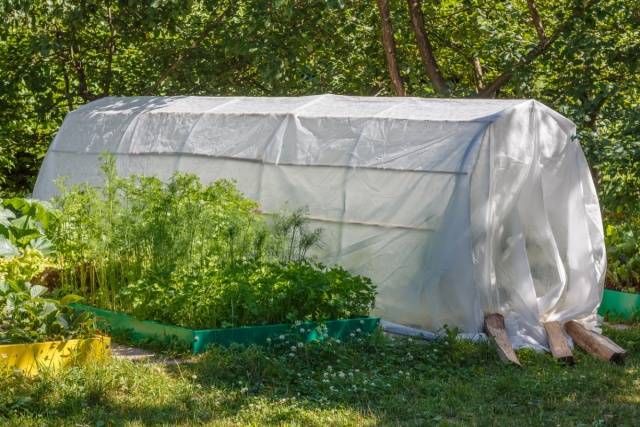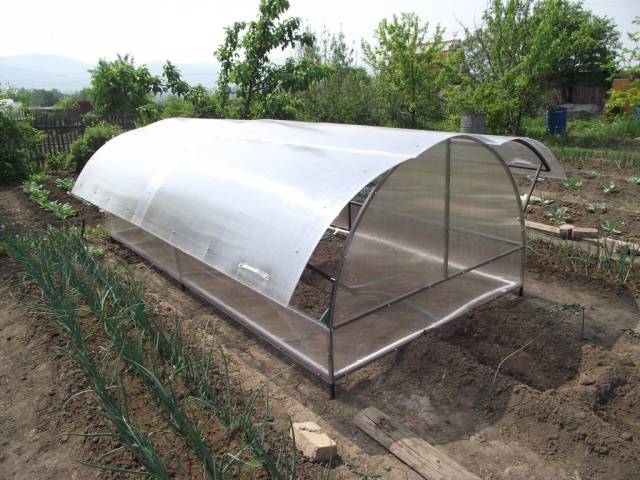Content
Tomatoes can also be grown in open ground, but then the harvest time is significantly delayed. Moreover, by the time the tomatoes begin to bear fruit, they are killed by cold and late blight. The natural desire of gardeners to get an earlier tomato harvest leads to the fact that they erect various protective structures for plants. Greenhouses and greenhouses are relevant not only for the northern regions, where warm weather sets in much later, but also for the middle zone with its unpredictable climate.
The simplest design can be bought in a store or built yourself. A small greenhouse for tomatoes will not require special physical effort or financial costs, and it saves space in areas where the construction of a large greenhouse is impossible.
Tomatoes in a greenhouse can be grown from the stage planting seedlings until harvest. The greenhouse can also be used for growing tomato seedlings. The method is suitable for central Russia. The seedlings are strong, resistant to temperature changes and diseases.
The benefits of growing in a greenhouse
Growing tomatoes in a greenhouse has a number of positive aspects:
- The time it takes to harvest tomatoes in a greenhouse is reduced;
- The plants are strong, hardened, and disease resistant;
- Tomatoes in a greenhouse do not stretch, as happens when growing seedlings in an apartment;
- Tomato seedlings are ready for planting in open ground, they do not have an adaptation period, they immediately begin to grow, which again significantly brings the harvest closer;
- Plants are protected from negative environmental influences;
- The greenhouse has a low cost; it can be built on your own from scrap materials, which will further reduce costs.
In order for the benefits of the greenhouse to be tangible, when constructing it, follow the basic requirements:
- The width of the structure should be no more than 1 m for ease of plant care. For larger sizes you will have to stand inside;
- The length, when using a film covering, is no more than 2 m, otherwise in windy weather the film will tear or be inflated by a sail, in rainy weather water will accumulate on the film and it will sag, it may bend the arcs or tear;
- When using glass or polycarbonate in the coating, the length can be either 4 or 5 m;
- The minimum height of the structure depends on the variety of tomatoes you plan to plant. A height reserve of at least 30 cm is required;
- Calculate the number of required arcs based on the length of the greenhouse in meters, plus 1 additional arc. So, if you are planning a structure 3 meters long, then you will need 4 arcs;
- Place the greenhouse for tomatoes in the sunny part of your garden plot. It is convenient to place it, adjoining it to the wall of a house or barn, so it becomes additionally insulated and more reliable. In this case, choose the wall that is oriented to the south.
Compliance with these requirements will allow you to operate the greenhouse as efficiently as possible.
Timing for planting tomatoes in a greenhouse
A greenhouse is a structure that is not heated or heated. Therefore, plant tomato seedlings in a greenhouse only if the soil has warmed up. An ordinary household thermometer will help determine when to plant tomatoes in a greenhouse. Temperature the soil must be at least +15 degrees. This is a must. You should not be fooled by the high daytime temperatures; night temperatures can drop to 0 degrees in the spring.
If spring is early and warm, then the timing may vary from mid-May to the end of the month. If weather conditions do not allow earlier planting, and if a film covering is available, then the best time to plant tomato seedlings is the end of May. If a polycarbonate coating is used, then mid-May is the most favorable time for planting tomato seedlings in a greenhouse.
You can grow seedlings from seeds yourself in a greenhouse. To do this, make a warm bed. Best fit horse dung. It is laid at the bottom, covered with sand, and prepared soil is placed on top. Manure, when decomposing, releases the necessary amount of heat. You can sow tomato seeds in such a bed. The greenhouse is not opened for the first 2 weeks until the shoots appear.
Video tips on how to warm the ground for early planting of seedlings:
When to sow tomato seeds in a greenhouse? Make some simple calculations. It takes 50-60 days to prepare seedlings for planting in open ground. Tomato seedlings are planted in unprotected soil in the first ten days to mid-June; therefore, sowing is carried out in April.
Be prepared for the fact that the weather sometimes presents unexpected surprises in the form of sudden cold snaps or recurrent frosts. Tomatoes in a greenhouse may die. In order not to be left without a crop, you can use an additional film covering so that there is an air gap between them. You can also cover the planted plants with modern materials: lutrasil or agrospan, but even the simplest covering with newspapers or burlap can completely protect tomato seedlings from frost.
Feeding tomatoes with Epin will protect plants from recurrent frosts. The principle of action of the drug is that it increases the accumulation of sugars in cells and the concentration of cell sap, and reduces the water content. Therefore, tomatoes do not freeze.
Be attentive to weather forecasts and protect your crops. Observe the timing of planting tomatoes in a greenhouse, otherwise you may lose the future harvest.
Greenhouse preparation
Successfully growing tomatoes in a greenhouse depends on how you prepare the soil. It's better to do it yourself to be sure of the result. Garden soil is not enough for tomatoes; it will only be the basis of greenhouse soil.
The soil taken from the garden must be enriched. There are several options for soil compositions for growing tomatoes in a greenhouse:
- Garden soil, peat, humus, taken in equal parts. If the mixture is measured in buckets, then add wood ash (0.5 l) and superphosphate (2 tbsp) to each bucket;
- Turf soil cleared of weed roots, peat, river sand, chalk (50 g). Sprinkle the mixture well with a solution of ready-made mineral fertilizers.
The main requirement for soil for tomatoes is that it should be light, nutritious, with normal acidity, and allow air and moisture to pass through well.
Tomatoes grow well in soil after the following crops:
- Cabbage;
- Cucumbers;
- Zucchini, squash, pumpkins
- Greens and radishes;
- Carrot;
- Turnip;
- Green manure.
The soil after:
- Tomato;
- Early potatoes;
- Pertsev;
- Eggplant.
If the greenhouse has been in the same place for several years, then the soil must be changed. Because late blight pathogens and various pests accumulate in it. In addition, the soil is very depleted; any cultivated plant absorbs a large amount of microelements from the soil. Therefore, it is necessary to return them there.
Replacing soil is a rather labor-intensive process. Experienced gardeners suggest using FAS sulfur bomb to disinfect the soil. When fumigating a greenhouse with a saber, pathogens and pests are destroyed. This measure is very effective.
After the procedure, the soil should be enriched with microelements. Compost made from horse manure with the addition of vermicompost (2 kg of mixture per bucket of soil) has worked well when growing tomatoes in a greenhouse.
The instructions for preparing the soil are simple and will help you grow tomatoes in a greenhouse until the harvest stage or grow tomato seedlings.
Preparing seedlings for planting in a greenhouse
No less pressing is the question of how to prepare tomato seedlings so that they survive relocation to a new place of residence well. The conditions of an apartment and a greenhouse are very different from each other.And temperature conditions, and the degree of illumination, and even the spectrum of sunlight the plants receive.
- If tomato seedlings are planted in separate containers in advance, this will protect the root system from damage. Plants will spend less time adapting. Because under unfavorable conditions, tomato seedlings take up to 2 weeks to recover. And only after that it begins to grow;
- Be sure to harden off the plants before planting in the greenhouse. To do this, 2-3 weeks in advance, they begin to expose them to cold air, opening the windows slightly, first for 1-2 hours, then gradually increasing the time. At the next stage of hardening, the seedlings are transferred to a balcony or loggia during the day, and when night temperatures become positive, they are left overnight. Those who have the opportunity take containers with tomato seedlings into greenhouses, but do not plant them yet;
- Preparatory activities include feeding tomato seedlings before planting in a greenhouse. This is done a week in advance to support the plants. The simplest fertilizing is a solution of wood ash or potassium chloride;
- Before planting a tomato in a greenhouse, watering is gradually reduced, and a week later, it is completely stopped. Spray flowering plants with a solution of boric acid (1 teaspoon per 1 liter of water). The procedure will protect flowers and buds from falling.
Healthy tomato seedlings have a strong stem, short internodes, and a well-developed root. The color of the leaves is rich green, there should be at least 6-10 of them, possibly the presence of buds.
Planting seedlings in a greenhouse
When planting tomato seedlings in a greenhouse, consider the following:
- You should not thicken the plantings, the plants will receive less sunlight, and there will be a threat of the development of diseases that love high humidity in thickened plantings. In addition, when tomato seedlings are planted densely, it is very difficult to care for them;
- The distance between plants should be at least 40 cm. Holes 20-30 cm deep are prepared for planting. Each hole is spilled with a solution of potassium permanganate for disinfection and additionally fertilized with humus, compost and ash. The wells are prepared in advance;
- Immediately before planting, the holes are spilled with plenty of water to create dirt, and the tomatoes are planted in the greenhouse. There is no need to deepen the plant. The root collar can be buried no more than 3 cm if the tomato seedlings have not outgrown;
- For overgrown seedlings, the hole is made deeper and the plant is buried deeper. But this is done gradually. Overgrown tomatoes are placed in a hole along with a lump of earth, they are at first as if in a hole, the earthen mixture is gradually added, every three days no more than 3 cm. This method allows tomato seedlings to grow the root system gradually. Tomatoes do not switch exclusively to the formation of additional roots; the plant develops and forms flower stalks. After planting tomatoes in a greenhouse, you do not need to water them immediately. At the initial stage there is enough moisture.
- The soil around the plants is compacted and mulched. The soil can be loosened between rows to reduce moisture. If everything is done correctly, then tomato seedlings in a greenhouse will quickly take root;
- Further care at first comes down to loosening; for the first 2 weeks, tomatoes in a greenhouse do not need watering. Then watering is resumed.Water infrequently, but abundantly;
- After three weeks, you can fertilize the tomatoes for the first time: potassium sulfate (30 g), superphosphate (50 g), and ammonium nitrate (15 g) are diluted in a bucket of water. For 1 plant use 1 liter of solution. The second feeding is three weeks after the first, and the final one is about a month from the end of the growing season.
Simple actions will preserve healthy seedlings and shorten the adaptation period. Video tips on growing tomatoes in a greenhouse:
Materials for making a greenhouse
A greenhouse differs from a greenhouse primarily in size and shape. The greenhouse is lower and more compact, so it is easier to create the conditions necessary for seedlings.
To build a greenhouse, much more space and financial investments are required; its construction is beyond the power of one person. And the greenhouse, thanks to its simplicity and size, can be mastered by everyone, even the weaker sex.
The base can be a metal structure or wood. You can also choose the coating at your discretion:
- Polyethylene film is a universal material, popular among gardeners, low cost, easy to stretch and fold, suitable for any frame. There are modern types of film: multilayer and reinforced, which will last for more than one season;
- Glass transmits sunlight well. Disadvantages: can only be mounted on a wooden base; it is technically very difficult to mount it on a metal base; glass is a fragile material and can be easily damaged if handled incorrectly;
- Polycarbonate is a modern universal material with a wide range of positive characteristics. Therefore, its popularity is gaining momentum every year. Thanks to its honeycomb structure, it diffuses direct sunlight.The material is durable, does not deform, and is attached to both a wooden and metal base. Installation of polycarbonate is not difficult.
The choice of coverage depends on your financial capabilities and how long you plan to use the greenhouse.
DIY tomato greenhouse
The simplest structures for tomatoes can be made independently:
- The simplest greenhouse made of arcs known to every gardener. Arcs made of polypropylene are stuck into the ground, a plastic film is stretched over it, which is securely fixed on the sides, pressed with bricks. To give strength, the structure can be reinforced with horizontal narrow bars. The best distance between the arcs is 50 cm. Video instructions for making a greenhouse:
- Another simple greenhouse made of wooden lattice. Quickly assembled without extra costs;
- Stationary builtThey have greater durability and practicality. They are more convenient to use. A box is made from boards onto which the frame is attached. Covering material is stretched over the frame. The advantage of a stationary greenhouse for tomatoes is that you can make the height as you wish or, based on the variety of tomato;
- Greenhouses with metal frame durable, they can be made collapsible, but their cost is quite high. You can use a polycarbonate coating;
- Greenhouse made from window frames can be made thorough. Now many people have old window frames in stock due to their replacement with plastic glazing. A thrifty owner will never lose anything. You will need: window frames, bricks for the foundation, bars and fasteners. Brick for the foundation is a little expensive to use, but it will last a long time, is stable and will withstand the weight of window frames.The length of the foundation will depend on the number of frames available. Don't make the greenhouse too long. This will cause inconvenience during operation. A beam is strengthened on top of the brick foundation, onto which boards of the required size are attached in 1 or 2 rows. The topmost side board is cut at an angle along its entire length. Window frames will be attached to the boards. The base can, of course, be made entirely of wood if the greenhouse is not planned to be used for too long.
It is better to make a greenhouse from old frames lean-to and have a hinged roof.
Manufacturers offer ready-made greenhouses:
- Butterfly greenhouse has rising sides, which ensures good ventilation and maximum sunlight and heat in good weather. When opened, it really resembles an insect with raised wings;
- Greenhouse-breadbox It is very convenient with its opening mechanism, similar to the type of container for storing bread that is used in kitchens. It is very lightweight, can be moved freely around the site, has a minimum of joints, which prevents cold air from penetrating inside;
- Belgian greenhouse It has a flat pitched roof, a very simple design, which maximizes its reliability. The convenient lifting mechanism also adds points to it. Suitable for growing tall varieties of tomatoes.
Our skilled gardeners can easily build such greenhouses for tomatoes on their own using factory samples.
Conclusion
A greenhouse is the simplest garden structure to protect tomatoes from cold weather, pests and diseases. With its proper operation and planting, you will not only get an early harvest of tomatoes, but also protect the plants from late blight.Setting up a greenhouse will not require significant financial costs, effort and time from you; it is easy to assemble and disassemble, and move it to a new location. Tomatoes are easy to care for and easy to regulate the internal temperature.































